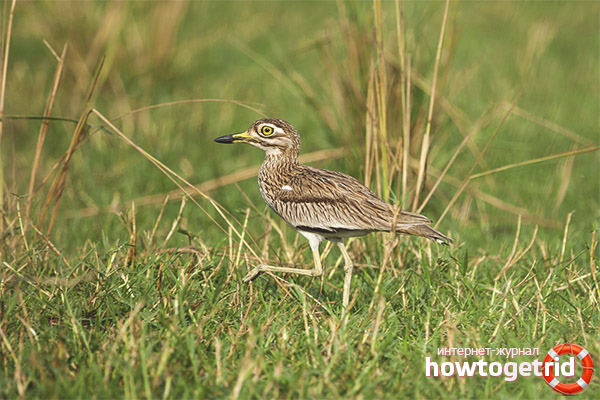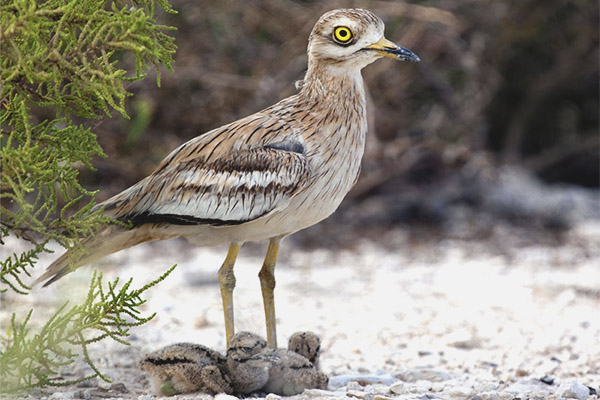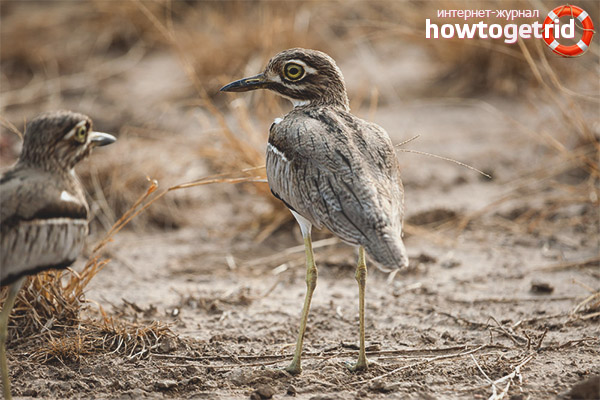The content of the article
In nature, you can meet a lot of birds of different types, size and color. But to enjoy the views and habits of the avid-up graceful motley bird in the daytime is very difficult - this bright inhabitant of the steppes lives and acts at night. What kind of bird is it, how does it live and where does it live?
Appearance
Avdotka looks like a sandpiper. It is known about the existence of 9 species of this bird from the family of avdotkovy squad charadriiformes. Ornithologists never agreed on this species. Some believe that the closest relatives of the avdotki are the bustard, while others believe that they are the sandpiper. The size of a little more urban pigeon, body length - from 38 to 47 cm. Very long tail - up to 25 cm. Weight varies from 500 grams. up to 1 kg. The wings are pointed at the end, have a span of up to 85 cm.
The plumage is rather peculiar - each white-gray feather is decorated with a light stripe and dark brown speck.This color serves as an excellent disguise, allowing you to hide in last year’s dry grass. Thin and long legs - yellow, most of the beak has the same yellow color, only the tip is black. The plumage of the breast and abdomen is white, with several black stripes on the chest. Externally, males and females are difficult to distinguish - neither in color nor in size.
Habitats
For nesting chooses bare treeless plains - places that are little overgrown with grass and lack of shrubs. It is desirable that the territory was sandy and rocky. Best of all are suitable steppe and terrain, full of hills. There avdotki and prefer to settle. They also choose rivers, small lakes and other bodies of water for settlement, nest near marshes, because there is a lot of suitable food in these places.
Lifestyle
Avdotka prefers nightlife.She sleeps in the grass during the day, imperceptible to anyone, and in the evening she begins to be active. Possessing good hearing and excellent eyesight, it is easy to find food.
Having a calm and peaceful disposition, conflicts with someone infrequently. It is not afraid of people, therefore, it often settles near villages, villages and farmsteads.
Flies silently, low over the ground, quickly flapping big wings. But, in general, prefers to move on the earth's surface on muscular paws. Even when danger threatens, running from her run. And runs pretty fast. Say, running away from a hunter, can run away while he is aiming, so far that the shot will not reach.
Nutrition

This bird is mostly carnivorous, feeding on animal food. Basically, it catches large insects, digs worms out of the ground. But able to catch food and bigger. Often, prey is a mouse, small lizards, frogs, small animals such as gophers, columns, hamsters.
Nesting and breeding
Avdotka love couples begin to form in the fourth year of life, before this period they do not need partners.In early April, the male, in order to attract the attention of the female, cries out loudly and melodiously, when the female switches attention to him, begins to dance. The dance consists of flapping wings, walking and flaunting in front of a partner.
These birds do not belong to those who like to be engaged in construction - they nest in any suitable shallow fossa. Two - three brownish-gray, similar to duck eggs are laid there, and the female sits down to hatch them. Sometimes a male takes her place, giving some respite to his spouse. The process of incubation lasts 26-27 days. At the end of this period, wet ruffled chicks appear. As soon as they dry out, the family immediately leaves this place.
The first 40 days of the life of young birds are nourished and fed by parents, getting ready-made food, but at the same time they are actively taught to find food on their own. Moreover, from early age they are taught to disguise themselves. It is funny to watch as very small fluffy bodies, with any hint of danger, huddle to the ground, dying in immobility.
Interesting
With danger, the avdotka quickly runs away from the enemy, or hides in the grass and freezes. The bird, hidden by thickets of grass of the same color as its coloring, is practically invisible.
At the beginning of the hunt the bird cries loudly - in the night it is heard excellently.But the meaning of the sound signal is not to warn the unwary victim: the cry scares various small rodents, who break away from secluded places and set off on the run. A running prey is much easier to detect and catch.
When an unfortunate animal hits the legs of an avdotka, it hits it with a strong beak, killing, and then repeatedly strikes the one caught on the stones, grinding and grinding the bones. He does this in order to make it easier to swallow prey - avdotka, unlike other birds, swallows the whole food without pecking it.
Avdotka insects pre-kills, only then eats.
Teaching small children to get food, shows great perseverance and great patience. The learning process is as follows: the bird grabs the prey from the ground with its beak, drops it again and waits for the baby to repeat it and do the same. From the first time, the child cannot do this, and the mother repeats again and again until the baby bird understands and learns.
When the chick hatching from the egg, the mother does not rise from the clutch, but picks up from under herself and eats the breakaway shells. After hatching, it grabs an empty shell and drags it away.
Avdotka does not know how to take off from a place like other feathered birds. To lift into the air, she must first run.
In case the nest is destroyed and the clutch is destroyed, after two and a half weeks, the eggs are again blown away.
Although avdotki and night birds, but during the mating games and hatching eggs to hunt out even in the daytime to feed the partner, carefully incubating eggs.
Over the past half century, the habitat avdotok significantly reduced due to increased human economic activity.
Video: Avdotka (Burhinus oedicnemus)












To send